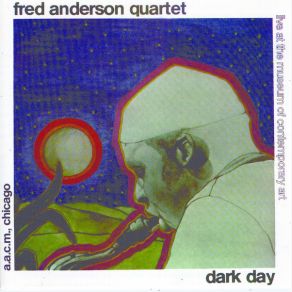Dark Day + Live In Verona
Download links and information about Dark Day + Live In Verona by Fred Anderson Quartet. This album was released in 1979 and it belongs to Jazz, Avant Garde Jazz genres. It contains 7 tracks with total duration of 02:12:51 minutes.

|
|
|---|---|
| Artist: | Fred Anderson Quartet |
| Release date: | 1979 |
| Genre: | Jazz, Avant Garde Jazz |
| Tracks: | 7 |
| Duration: | 02:12:51 |
| Buy it NOW at: | |
| Buy on iTunes $19.99 | |
| Buy on Amazon $17.98 | |
| Buy on iTunes $19.99 | |
Tracks
[Edit]| No. | Title | Length |
|---|---|---|
| 1. | Dark Day | 18:40 |
| 2. | Saxoon | 11:36 |
| 3. | Three On Two | 18:07 |
| 4. | The Prayer | 10:54 |
| 5. | The Bull | 16:33 |
| 6. | Three On Two | 31:49 |
| 7. | Dark Day | 25:12 |
Details
[Edit]John Corbett's Unheard Music Series of out jazz and improv classics, which is being released and distributed by Chicago's Atavistic label, has provided listeners a second opportunity to hear music that slipped through the cracks either because the label it originally appeared on was too small or because it was ignored due to its power and danger. In the case of saxophonist Fred Anderson, the package is a double treat because it pairs a very rare 1979 live date in his hometown of Chicago with members of the AACM (issued in an edition of only a few hundred on Message Records) with a completely unreleased master recorded four days later in Verona, Italy. The band is comprised of Anderson on tenor, longtime associate Billy Brimfield on trumpet, bassist Steven Palmore, and a very young Hamid Drake, then known as Hank, on drums. Musically, both sessions repeat two tunes, "Three on Two" and "Dark Day." The mournful "Dark Day" is an Anderson signature piece, with its long modal beginning twinning Anderson and Brimfield in elegantly moaning lines that engage the rhythm section at the periphery. On disc one, this is followed by the relatively straight post-bop blues of "Saxoon," in which both front-line players trade solos along an augmented blues figure by Palmore and a skittering skein of double- and triple-time dancing by Drake. With "Three on Two," both performances begin in Eastern tonal modes, syncopated by choppy lines and odd meters and durations of melodic particulars. On the earlier date, the band cuts loose sooner, moving through the Eastern modes and inserting a Latin-tinged blues into the center of the cut-time figure. On the latter, the band moves to Anderson's solo and shifts to the margin and outside of the Latin harmony toward some synthesis of rhythm and extended microtonality. The other two selections on these discs, Drake's "The Prayer," from Chicago, and Anderson's classic "The Bull," are both energetic — even hyperkinetic — ensemble pieces where solos and improvisational explorations take place from the ground up. Obviously in the case of "The Prayer," it's rhythm first and then the explosion of trumpet and saxophone interweaving that encounters it, moves through it, and then attempts to transform the concept of rhythm into one of elongated harmonics that go beyond scalar considerations and into the roots of scales themselves. On "The Bull," it's harmony and the way it functions against polytonality and an unfixed sense of rhythmic push and pull, where rhythm doesn't stand so much in opposition to the intricate melodic considerations — Brimfield truly shines here — but instead as a counterpoint to harmonic invention and an intervallic foil for Anderson to take microharmonic statements and build them in gargantuan language structures. Anyway you listen to it, these two dates on a pair of very reasonably prices CDs — with great sound — are gifts rescued from the islands of obscurity, and should be listened to with the awe and wonder they inspire.